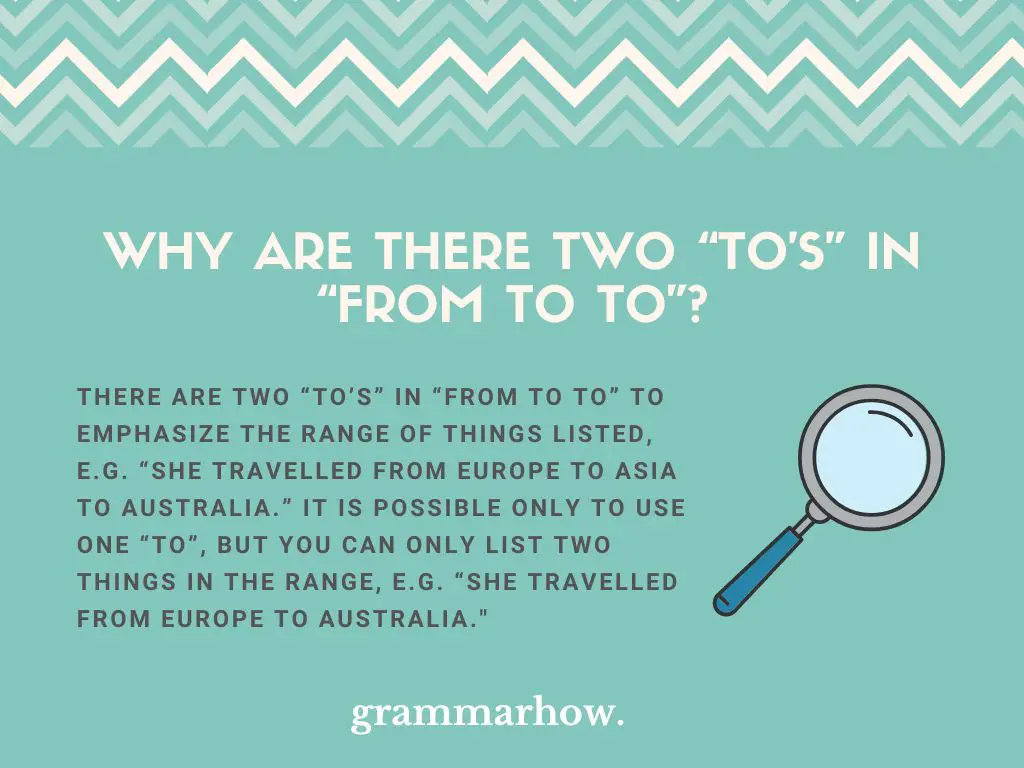The structure “from…to… to…” is confusing to English learners and natives. Additionally, many people are confused about why there are two examples of the word “to” and whether there are commas in “from…to… to…”.
Why Are There Two “to’s” in “From to to”?
There are two “to’s” in “from to to” to emphasize the range of things listed, e.g. “She travelled from Europe to Asia to Australia.” It is possible only to use one “to”, but you can only list two things in the range, e.g. “She travelled from Europe to Australia.”

Therefore, as a way of emphasizing the range of different possibilities you are listing, you can add as many “to`s” as you wish.
Furthermore, you do not need to place commas between the things you are listing in a “from…to… to…” sentence.
Here are some examples of “from…to… to…” in a sentence:
- She travelled far and wide, from Europe to Asia to Australia to South America. She went everywhere!
- Rats eat everything from trash to other animals to plastic.
- We went everywhere from north to south to east to west. We traversed the whole city.
Comma Placement With “From to to”
You do not need to use commas to separate the things in the range in a “from…to… to…” sentence. Sometimes, there may be a comma before the “from” depending on the sentence type and what precedes the word “from”. For example:
- We eat most foods in this house, from Asian to Mexican to British to Middle Eastern.
Sometimes you may also need to place a comma after the final item if another clause follows it. However, in the list section, you do not need commas between the “to`s.” Here’s an example:
- He asked around from Walmart to Tesco to Costco, and none of them had chocolate cakes.
You may also like: “From X to Y to Z”: Comma Placement & Meaning (+Examples)
Other Ways to Write “From to to”
The sentence structure “from…to… to…” is relatively common, and there is nothing wrong with using it as a way of emphasizing a range or simply listing a range of items.
However, there are other ways you could write a list that doesn’t involve using “from…to… to…”.
Including
The simplest way is to use a standard list with the word “including” along with commas and conjunctions. This is the traditional method used to list a range of items, although it doesn’t really add emphasis to the range of things unless you add other words.
Here are some examples:
- We eat everything in this house, including Asian, Indian, Mexican, and American food.
- She has travelled everywhere, including Europe, Asia, Africa, and the Middle East.
- He can do anything around the house, including plumbing, roofing, and building.
As well as/In addition to
The term “as well as” and “in addition to” mean the same thing and are used in the same way. You can add them to the end of the list to introduce “additional” items to the list.
They are helpful when there is a contrast between the items mentioned first and those appearing at the end of the list.
- He can do anything around the house, from plumbing to electric work, as well as cooking and cleaning.
- We asked in every supermarket, from Walmart to Costco, in addition to Tesco, and they still didn’t have any milk.

Martin holds a Master’s degree in Finance and International Business. He has six years of experience in professional communication with clients, executives, and colleagues. Furthermore, he has teaching experience from Aarhus University. Martin has been featured as an expert in communication and teaching on Forbes and Shopify. Read more about Martin here.

